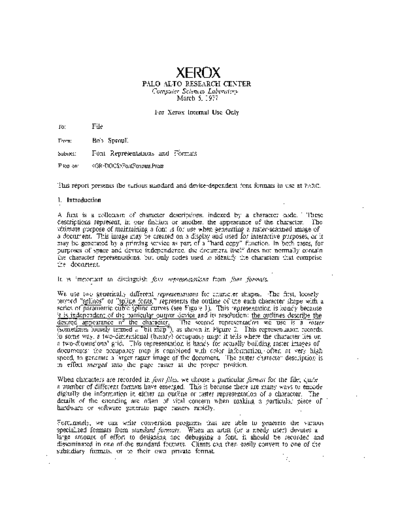Service Manuals, User Guides, Schematic Diagrams or docs for : xerox alto printing Font_Representations_and_Formats_Mar77
<< Back | HomeMost service manuals and schematics are PDF files, so You will need Adobre Acrobat Reader to view : Acrobat Download Some of the files are DjVu format. Readers and resources available here : DjVu Resources
For the compressed files, most common are zip and rar. Please, extract files with Your favorite compression software ( WinZip, WinRAR ... ) before viewing. If a document has multiple parts, You should download all, before extracting.
Good luck. Repair on Your own risk. Make sure You know what You are doing.
Image preview - the first page of the document

>> Download Font_Representations_and_Formats_Mar77 documenatation <<
Text preview - extract from the document
XEROX
PALO ALTO RESEARCH CENTER
Computer Sciences Lahoratol),
March 5, 1977
For Xerox Internal Use Only
To: File
From: Bob Sproull
Subject: Font Representations and Formats
Filed on: Fred.Press. The program is on Fred.Dm.
PREPRESS: Interactive program for building standard raster font representations. The
program also contains numerous options for converting from standard to subsidiary
fonnats. Documentation is on PrePress.Press. . The program is on
.PrePress.Run.
COMPRESS: A program that converts .CU fonnat to EARS (.EP and .EL) fonnats. The
program is on Compress.Run.
The reader is invited to consult PrePress documentation for miscellaneous lore relating to
fonts and for "standard operating procedures" for maintaining font files.
People
This document is simply a convenient summary of fonnats and techniques developed by a
large number of individuals. The people behind the fonnats include Patrick Baudelaire,
Peter Deutsch, Diana Merry, Ron Rider, Bob Sproull, Larry Tesler, and Chuck Thacker.
2. Terminology
The tenninology that has developed around fonts is hopelessly inconsistent. This section is
intended to serve as a glossary for the descriptions in the remainder of this document. Be
forewarned that tenninology used elsewhere may not match.
2.1 Characters
Family is the tenn given to a particular design of characters. Examples of families are
"Times Roman," or "Helvetica."
Point size of a character refers to size measurements used in. the printing industry. If text is
n points high, this means that closely-spaced lines of text will fall nl72 inches apart on the
page. Note that the point size does not relate in any consistent way to the geometry of
characters, e.g., to the height of an upper case A.
Face denotes a number of attributes of a particular font: italic. bold, light, condensed,
expanded are all attributes of the font. Sometimes this is called a "style." Sometimes the
Font Representations and Formats 3
face is defined with a three-letter code: the first letter is L for light, M for medium, or B for
bold; the second is R for regular or I for italic; the third is C for condensed, R for regular or
E for expanded.
Rotation refers to the orientation of the character. If a string of characters is intended to be
horizontal, it has rotation zero; if a string runs vertically upward, it has a rotation of 90
degrees.
Font, as we use the term, refers to a collection of characters of the same family, the same
size, the same rotation, and the same face attributes.
Character code refers to a number (usually only 8 bits) that identifies a character. All our
fonts use standard ASCII conventions, when the conventions are meaningfu1. For special-
character fonts (e.g., mathematics, logic design), another mapping must generally be devised.
Origin of a character (sometimes called "the (0,0) point") is conceptually a reference mark
that is used to describe a character's location on a page or display. Thus a directive to
"display an A at x=103, y=204" is interpreted to mean "place an instance of the symbol A on
the display so that the character origin coincides with the coordinate x = 103, y = 204." Figures
1 and 2 show the origin of a sample character.
Width of a character is a two-dimensional vector that represents the incremental translation
that should take place to determine the placement of the origin of the next character to be
displayed in a (conventionally aligned) string of characters. In the example of Figure 3, if
we assume the x direction points to the right and the y direction up, we see that the width
vector has a zero y component.
In all our font representations, we associate the width vector with each character code: If this width
vector is used for character positioning, the spacing between the origin of a A (say) and the origin of
the next character is independent of that next character. This is not always desirable: because of the
different shapes of characters, spacing between differing pairs may want to be adjusted slightly to make
the text line appear more pleasing.
Bounding box is the term for a rectangle that just barely surrounds the character (see Figure
3). It is characterized by its width and height, and by a two-dimensional vector that
specifies where the lower-left corner of the bounding box is with respect to the origin of the
character inside. These four numbers are named (in this document) BBdx, BBdy, BBox, and
BBoy.
The font bounding box is a bounding box that applies to all characters in the font. That is,
if all the characters in the font were placed with their origins coincident, the smallest
rectangle that encloses every part is the font bounding box. The four parameters of the font
bounding box are named (in this document) FBBdx, FBBdy, FBBox, and FBBoy
The coordinate system assumed for this document is that x points to the right on a
(portrait-oriented) page, and y points up. A mica is a unit of measure, equal to 10 ◦ Jabse Service Manual Search 2024 ◦ Jabse Pravopis ◦ onTap.bg ◦ Other service manual resources online : Fixya ◦ eServiceinfo